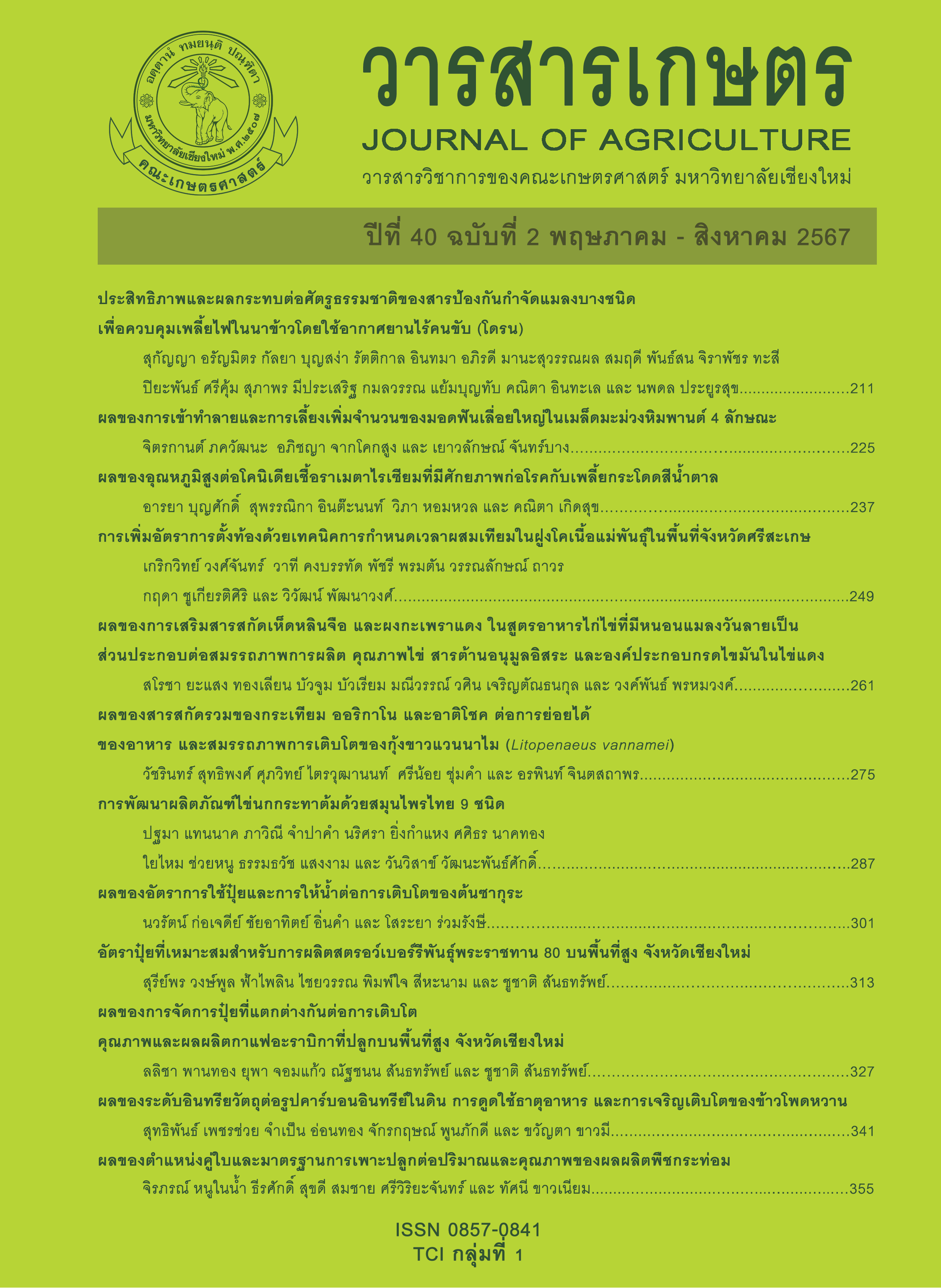Effects of Fertilizer Rates and Watering on Growth of Sakura (<I>Prunus serrulata</I>)
Main Article Content
Abstract
Sakura (Prunus serrulata) is an important perennial plant in Japan. Currently, Thailand has imported Sakura trees for planting in the highlands to promote agrotourism. However, the basic information on Sakura cultivation in Thailand was limited. The objective of this research was to study the fertilizer rates and watering on the growth and physiological changes of cherry blossoms. The experimental design was factorial in CRD with 4x3 factorial treatments, 5 replications using one year old of plant as plant material. First factor 1 was, four watering frequency i.e., 1) every day 2) every 2 days 3) every 4 days and 4) once a week. Each plant was supplied with 1 liter of water per time. Second factor was three fertilization rates i.e.,1) no fertilizer 2) 5 g of 15-15-15 (N-P2O-K2O) /pot and 3) 10 g of 15-15-15 (N-P2O-K2O) /pot. Plant height (cm), number of branches per plant, branch length (cm), photosynthetic rate (µmol m-2s-1), stomatal conductance (mol m-2s-1), and transpiration rate (mmol m-2s-1) were measured. The results showed that in 4 months after starting treatment, fertilizer rates and watering frequency did not affect growth of Sakura in terms of plant height, number of branches per plant and branch length and there was no interaction between factors. In case of physiological changes, the result found that watering once a week gave the highest of transpiration rate at 1.99 mmol m-2s-1. In addition, interaction between factors was found on stomatal conductance and transpiration rates.
Article Details

This work is licensed under a Creative Commons Attribution-NonCommercial-NoDerivatives 4.0 International License.
References
Asma, B.M., S. Colak, Y. Akca and C. Genc. 2007. Effect of fertilizer rate on the growth, yield and fruit characteristics of dried apricot (cv. Hacihaliloglu). Asian Journal of Plant Sciences 6(2): 294 - 297.
Banon, S., J.A. Fernandez, J.A Franco, A. Torrecillas, J.J. Alarcón and M.J. Sánchez-Blanco. 2004. Effects of water stress and night temperature preconditioning on water relations and morphological and anatomical changes of Lotus creticus plants. Scientia Horticulturae 101(3): 333-342.
Benlloch-González, M., O. Arquero, J.M. Fournier, D. Barranco and M. Benlloch. 2008. K+ starvation inhibits water stress induced stomatal closure. Journal of plant physiology 165(6): 623-630.
Brag, H. 1972. The Influence of Potassium on the Transpiration Rate and Stomatal Opening in Triticum aestivum and Pisum sativum. Physiologia Plantarum 26(2): 250-257.
Hatfield, J.L., T.J. Sauer and J.H. Prueger. 2001. Managing soils to achieve greater water use efficiency: a review. Agronomy Journal. 93(2): 271-280.
Inoti, S.K. and D. Cherop. 2022. Appropriate watering interval for Prunus africana nursery seedlings in Egerton University, Njoro, Kenya. International Journal of Science and Research Update 3(01): 034-039.
Jiang, D., X. Shen and B. Shen. 2022. Prunus conradinae ‘Luoshifener’, a Flowering Cherry Cultivar with a Strong Aroma. HortScience 57(11): 1473-1474.
Kaweeta, L., M. Na-Nakhon, S. Suwanwong and S. Tantiwiwat. 2009. Plant Physiology. 2nd ed. Kasetsart University, Bangkok. 261 p. (in Thai)
Kuitert, W. and A.H. Peterse. 1999. Japanese Flowering Cherries. Timber Press, Portland, Oregon. 436 p.
Ky-Dembele, C., J. Bayala, P. Savadogo, M. Tigabu, P.C. Odén, I.J. Boussim, B. Ky-Dembele, C. Bayala, P. Tiguba and P.C Boussim. 2010. Comparison of growth responses of Khaya senegalensis seedlings and stecklings to four irrigation regimes. Silva Fennica 44(5): 787-798.
Wang, L.L., J.A. Palta, W. Chen, Y.L. Chen and X.P. Deng. 2018. Nitrogen fertilization improved water-use efficiency of winter wheat through increasing water use during vegetative rather than grain filling. Agricultural Water Management 197: 41-53.
Martínez-García, P.J., J. Hartung, F. Pérez de los Cobos, P. Martinez-Garcia, S. Jalili, J.M. Sanchez-Roldan, M. Rubio, F. Dicenta and P. Martinez-Gomez. 2020. Temporal response to drought stress in several prunus rootstocks and wild species. Agronomy 10(9): 1383, doi.org/10.3390/agronomy10091383.
Pascual, M., J. Lordan, J.M. Villar, F. Fonseca and J. Rufat. 2013. Stable carbon and nitrogen isotope ratios as indicators of water status and nitrogen effects on peach trees. Scientia Horticulturae 157(7): 99-107.
Rutkowski, K. and G.P. Lysiak. 2023. Effect of nitrogen fertilization on tree growth and nutrient content in soil and cherry
leaves (Prunus cerasus L.). Agriculture 13(3): 578, doi: 10.3390/agriculture13030578.
Scagel, C.F., G. Bi, L.H. Fuchigami and R.P. Regan. 2011. Effects of irrigation frequency and nitrogen fertilizer rate on water stress, nitrogen uptake, and plant growth of container-grown rhododendron. Hort Science 46(12): 1598-1603.
Scheiber, S.M., E.F. Gilman, M. Paz, and K.A. Moore. 2007. Irrigation affects landscape establishment of Burford holly, pittosporum, and sweet viburnum. HortScience 42(2): 344-348.
Shaw, B., T.H. Thomas and D.T. Cooke. 2002. Responses of sugar beet (Beta vulgaris L.) to drought and nutrient deficiency stress. Plant Growth Regulation 37: 77-83.
Shober, A.L., K.A. Moore, C. Wiese, S.M. Scheiber, E.F. Gilman, M. Paz and S. Vyapari. 2009. Posttransplant irrigation frequency affects growth of container-grown sweet viburnum in three hardiness zones. HortScience 44(6): 1683-1687.
Sruamsiri, P. 2011. Mineral Nutrient for horticulture crop production. Wanida Karnpim, Chiang Mai. 326 p. (in Thai)
Zhang, Y.Q., J.D. Wang, S.H. Gong, D. Xu and J. Sui. 2017. Nitrogen fertigation effect on photosynthesis, grain yield and water use efficiency of winter wheat. Agric Water Manage 179: 277-287.


